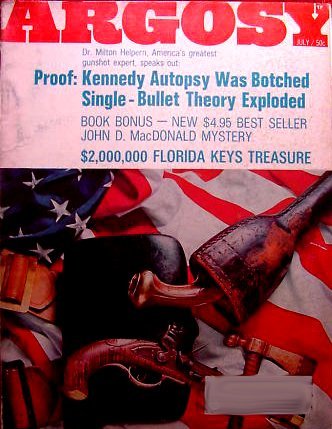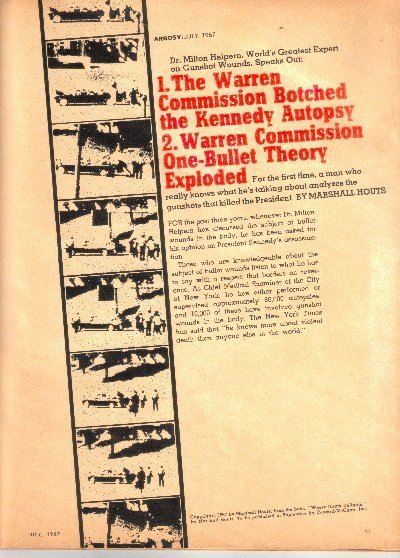1. The Warren Commission Botched the Kennedy Autopsy
2. Warren Commission One-Bullet Theory Exploded
For the first time, a man who really knows what he's
talking about analyzes the gunshots that killed the President.
FOR
the past three years, whenever Dr. Milton Helpern has discussed the
subject of bullet wounds in the body, he has been asked for his opinion
on President Kennedy's assassination.
Those who are knowledgeable
about the subject of bullet wounds listen to what he has to say with a
respect that borders on reverence. As Chief Medical Examiner of the
City of New York, he has either performed or supervised approximately
60,000 autopsies; and 10,000 of these have involved gunshot wounds in
the body. The New York Times has said that "he
knows more about violent death than anyone else in the world."
No
one can come close to matching his vast experience with bullet wounds.
Dr. Helpern's book, "Legal Medicine, Pathology and Toxicology," was
cited as the standard reference work on the subject by Lieutenant
Colonel Pierre Finck, one of the doctors who assisted in the autopsy on
President Kennedy's body, in his testimony before the Warren Commission.
It
now seems incredible that Dr. Helpern's opinion was not one of the
first sought when the official investigation into the President's death
was launched. It has not yet been asked for, either officially or
unofficially, by anyone connected with the Warren Commission.
"The
Warren Commission," Dr. Helpern says, shaking his head sadly, "was a
tragedy of missed opportunities for forensic medicine. Its entire
approach to the problems of the President's wounds shows a total lack
of familiarity with the subject. The Warren Commission had an
opportunity to settle, once and for all, a great many of the confusing
doubts, but because none of its members or its legal staff had any
training or knowledge in forensic medicine, those opportunities fell by
the wayside. It is tragic! Really tragic!"
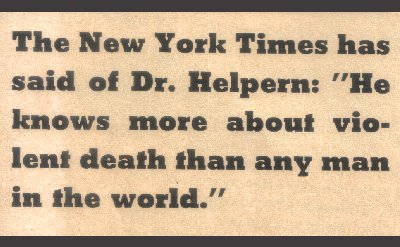
Almost
every week, Dr. Helpern plays host to some official visitor from a
foreign country whose specialty is forensic medicine, and invariably
the subject of the assassination comes up.
"I am continually
amazed," he says, "at the refusal of the Europeans to accept the
conclusions of the Warren Commission as being fact. Millions of
Europeans apparently still feel strongly that the Commission report was
nothing but a whitewash of some kind to cover up a vicious conspiracy.
My friends in forensic medicine who have read the report in detail -
and it seems that most of them have - simply cannot believe that the
examination and evaluation of the President's bullet wounds could have
been handled in the manner which the report describes.
"I am
talking now only about the medical evaluation of the bullet wounds
themselves, nothing else. The FBI certainly did a commendable job on
the other phases of the case, but the FBI had to rely entirely on the
medical information furnished it by the three doctors who performed the
autopsy. The FBI does not have its own experts in forensic medicine.
There is no reason for them to have. The FBI undoubtedly has had more
experience with firearms identification - that is, matching a
particular bullet to a particular gun - than any other agency in the
world; but the FBI is seldom called upon to investigate a murder.
Murder is a crime which usually involves a state jurisdiction only.
Bullet wounds in the body are not the FBI's long suit."
[EDITOR'S
NOTE: And so is death by poisoning. In April, Dr. Helpern won a
toe-to-toe confrontation with the nation's top criminal lawyer, F. Lee
Bailey, when Dr. Carl A. Coppolino was convicted in Naples, Florida, of
murdering his wife, Carmela. Dr. Helpern and his assistants convinced a
jury that Dr. Coppolino had injected a lethal dose of succinylcholine
chloride, a muscle-relaxing drug, into Carmela's left buttock. The
result was death by suffocation.
Bailey's effort to counter the testimony of Dr. Helpern
and his assistants with experts of his own proved futile.]
Even
allowing for the vagaries of individual bullet wounds, it has been
possible to formulate some general principles which permit the experienced
forensic pathologist to be reasonably accurate in his calculations.
Regardless of the number or position of the bullet wounds in the body
in a given case, the first step is to determine whether each wound is a
wound of entrance or a wound of exit.
When a bullet strikes the
skin, it first produces a simple indentation, because the skin is both
tough and elastic, and the tissues underneath are not rigid and
resistant. This stretches the skin immediately under the nose of the
bullet. The bullet, which is rotating as well as moving forward, is
definitely slowed up at this point of first contact, but it then more
or less bores its way through the skin and the tissues underneath, and
courses on into the body. The skin is stretched by the bullet at the
point at which it passes through; it then returns to its former
condition, so that the size of the wound of entrance appears to be
smaller than the diameter of the bullet which made it. Usually, there
is only a small amount of bleeding from wounds of entrance, since
tissue destruction at this point is not great. These rules apply to
bullet wounds that are the result of the gun being fired at distances
in excess of twenty-four inches. A different set of rules applies when
the gun is held in direct contact with the skin or is fired from a
distance less than twenty-four inches.
Wounds of exit, on the
other hand, are usually larger than the bullet, since the bullet tends
to pack tissues in front of it. These wounds are ragged, torn, and
sometimes have shreds of fat or other internal tissues extruding from
them. As a result, wounds of exit may bleed far more extensively than
wounds of entrance. This, however, is not invariably the case.
"You
always are guided by the general rules that apply to bullet wounds."
Dr. Helpern says, "but you must also be on guard for the bizarre, the
unusual, the once-in-a-million case, the wounds that, to the novice,
seem to defy physical laws. It is not a job for the beginner or the man
whose knowledge is limited to a lecture or two, or to what he has read
in some article or textbook."
To fully appreciate the gravity of
Dr. Helpern's observations on the medical facts of President Kennedy's
death, it is necessary to go back to the historic day of Friday,
November 22, 1963.
Sometime between twelve-thirty p.m., when the tragedy
struck in Dallas, and the arrival of Air Force One
at Andrews Air Force Base just outside of Washington at
five-fifty-eight p.m., Mrs. Kennedy decided that the autopsy on her
husband's body should be performed at the Naval Medical School in
Bethesda, Maryland. She was given two choices: either the Army's Walter
Reed Hospital or Bethesda. She selected the Naval Medical School
because of the President's World War II service in the Navy.
Certainly,
Mrs. Kennedy could not be expected to have any knowledge of forensic
medicine; and in her hour and the nation's hour of shock and
bereavement, she made a logical choice. The point that disturbs Dr.
Helpern, however, is the fact that the choice was left to her. It was
not only an unpleasant, additional personal burden which should have
been spared her, but it indicates as well the total lack of
understanding of the subject of forensic medicine.
"It shows," he
says, "that we are still laboring under the delusion that an autopsy is
a computerized, mathematical type of procedure, and that any
doctor is capable of performing it, especially if he is a pathologist.
If he can run a correct urinalysis, ergo this automatically qualifies
him as an expert on bullet wounds in the body.
There can be no
doubt but that this fallacious assumption was the real spawning ground
for the contagious rash of anti-Warren Commission books that have
poured out during the past three years. Their genesis can be traced
directly to what was done and not done in a single operating room in
the Naval Medical School in the evening hours of Friday, November 22,
1963.
The autopsy was performed by Commander James J. Humes,
assisted by Commander J. Thornton Boswell and Lieutenant Colonel Pierre
Finck.
In testimony before the Warren Commission, Commander
Humes, director of the Naval Medical School at the Navy Medical Center
at Bethesda, established himself as a qualified pathologist. He
admitted, though, that his practice had been "more extensive in the
field of natural disease than violence."
In short, the author says, "Humes was a 'hospital'
pathologist, rather than a forensic or medico-legal pathologist."
The
hospital pathologist performs his autopsies on cases where death occurs
in a hospital, usually as a result of some disease and where the cause
of death can be presumed. It is generally performed to confirm a
diagnosis.
A forensic pathologist, on the other hand, performs
autopsies usually where death is not attended by a physician. In these
cases, a pathologist often follows misleading, frustrating clues. His
work is much trickier, since cause of death is often crucial to
subsequent legal action.
"The 'hospital' pathologist," the author
says, "is as much out of his field when he attempts a medico-legal
autopsy as is the chest surgeon who attempts a delicate brain
operation."
The Warren Commission did not attempt to establish
the expertise of Commander Boswell in gunshot wounds, the author says,
because "he had absolutely none worthy of mention." Commander Boswell
was chief of pathology at the Naval Medical School.
Colonel
Finck, who was then chief of the Wound Ballistics Pathology branch of
the Armed Forces Institute of Pathology, told the Warren Commission
that he had personally performed about 200 autopsies for the Army in
Frankfurt, Germany, while serving there from 1955 to 1958. In his
current capacity, he said, he had personally reviewed 400 autopsies.
But
he was vague on the number of bullet-wound cases in his 200 personally
performed autopsies, except to say that there were "many." Moreover,
the fact that he reviewed 400 cases did not mean that he "presided at
the autopsy table and attempted a personal evaluation of whether a
bullet wound...is a wound of entrance or a wound of exit."
The
author says that Colonel Finck was perhaps the most qualified of the
three who performed the autopsy on the President, but adds that his
experience was mostly "supervisory and administrative."
The men
were accomplished in their respective fields of general pathology, the
author sadly concludes, but their field "was not bullet wounds in the
body."
One of the key aspects of the autopsy was to determine
whether the front neck wound was one of entrance or exit. If it was an
entry wound, then a second assassin was indicated.
Unfortunately,
this was difficult to determine, since Dr. Malcolm O. Perry had
performed a tracheotomy at Parkland Memorial Hospital in Dallas in a
futile attempt to save the President's life, thus obscuring the neck
wound. At no time in Dallas was the body turned over to look for a
corresponding wound in the back, and therefore the front neck wound was
assumed to be an entrance wound.
The difficulties encountered by
the autopsy surgeons were compounded by the fact that Commander Humes
first talked to Dr. Perry the morning after the autopsy, when the body
was already resting in the White House. Thus they had worked under the
assumption that there were only three bullet wounds - the two in the
head and the one in the back of the neck, since they attributed the one
in the front of the neck to the tracheotomy.
They thus assumed,
in their "inexperienced efforts" to probe the neck wound, that a third
bullet had been found on a stretcher at Parkland, they abandoned their
search.
In testimony before the Warren Commission, Commander
Humes expressed no doubt that the wound in the throat was a wound of
exit - even though the only ones who saw the original wound were the
doctors in Dallas. And this was before they made the tracheotomy that
extended the wound.
In other testimony, both Dr. Perry and Dr.
Charles S. Carrico, resident surgeon at Parkland, said they could not
determine whether the wound was one of entrance or exit. "It could have
been either," Dr. Carrico said.
This was the testimony that
satisfied the Commission and permitted it to conclude that "the
findings of the doctors who conducted the autopsy were consistent with
the observations of the doctors who treated the President at Parkland
Hospital."
"The tragic, tragic thing," Dr. Halpern explains in
summarizing his comments on the medico-legal aspects of President
Kennedy's death, "is that a relatively simple case was horribly botched
up from the very beginning; and then the errors were compounded at
almost every other step along the way. Here is a historic event that
will be discussed and written about for the next century, and gnawing
doubts will remain in many minds, no matter what is done or said to
dispel them."
What were these step-by-step errors?
"I've
already touched on the gravest of them all - the selection of a
'hospital' pathologist to perform a medico-legal autopsy. This stemmed
from the mistaken belief that because a man can supervise a laboratory
or perform a hospital autopsy to see whether a patient died from
emphysema or heart disease, he is qualified to evaluate gunshot wounds
to the body. It's like sending a seven-year-old boy who has taken three
lessons on the violin over to the New York Philharmonic and expecting
him to perform a Tchaikovsky symphony. He knows how to hold the violin
and bow, but he has a long way to go before he can make music."
Does this observation apply to Lieutenant Colonel Pierre
Finck?
"Colonel
Finck's position throughout the entire proceeding was extremely
uncomfortable. If it had not been for him, the autopsy would not have
been handled as well as it was; but he was in the role of the poor
bastard Army child foisted into the Navy family reunion. He was the
only one of the three doctors with any experience
with bullet
wounds; but you have to remember that his experience was limited
primarily to 'reviewing' files, pictures and records of finished cases.
There's a world of difference between standing at the autopsy table and
trying to decide whether a hole in the body is a wound of entrance or a
wound of exit, and in reviewing another man's work at some later date
in the relaxed, academic atmosphere of a private office. I know,
because I've sweated out too many of these cases during the past
thirty-five years. Colonel Finck is extremely able in the type of
administrative work which has been assigned him over the years."
Are
there any crucial steps that should have been taken that were omitted
that Friday evening in the autopsy room at the Naval Medical School?
"The
major problem in any gunshot case, of course, is to determine which is
the wound of entry and which the wound of exit. This is basic. All the
so-called critics of the Warren Commission Report would be left
dangling in mid-air with their mouths gaping unless they can suggest or
argue that the hole in the front of the President's throat was a wound
of entrance. Deprive them of this opportunity for speculation and you
pull the rug right out from under them. Give it to them - and they now
have it - and they can bring in all kinds of unreliable eyewitness
reports of shots coming from the bridge across the underpass, or from
behind the screen of trees in Dealey Plaza, and puffs of blue smoke
that remained suspended in the air with police officers scrambling up
the bank to investigate these illusory puffs of smoke. Smoke from
gunshots just doesn't behave like that."
Specifically, how could
a positive determination have been made at the time of the autopsy that
the throat wound was a wound of exit or a wound of entrance?
"In
a great many cases, the only safe way to reach a conclusive decision is
to compare the size and characteristics of each wound on the end of the
wound track. It's easy for textbook writers and their readers to assert
pontifically that the wound of exit is always
larger than the wound of entrance, and the wound of exit is ragged
whereas the wound of entry is smooth, so that you have no difficulty in
taking a gross, eyeball look and saying, 'this is the entry wound' or
'that is the exit wound.' This isn't true at all. The
difference
between the entry wound and the exit wound is frequently a lot more
subtle than that. Many of the wounds require careful and
painstaking study before you can reach a decision."
But wasn't
the throat wound gone at the time of the autopsy? In one
place,
the Warren Commission Report states: "At that time they [the autopsy
surgeons] did not know that there had been a bullet hole in the front
of the President's neck when he arrived at Parkland Hospital because
the tracheotomy incision had completely eliminated that evidence."
At another point, the report says: "...since the exit wound
was
obliterated by the tracheotomy."
"No, you see, the staff members
who wrote that portion of the report simply did not understand their
medical procedures; and they did not know enough to seek medical
guidance. Here's what the autopsy protocol says about this
throat
wound; '...it was extended as a tracheotomy incision and thus its
character is distorted at the time of autopsy.' The key word
here
is extended.
That
bullet wound was not 'eliminated' or 'obliterated' at all.
What
Dr. Perry did was to take his scalpel and cut a clean slit away from
the wound. He didn't excise it or cut away any huge amount
of
tissue, as the report writer would have you believe."
What about the description in the autopsy protocol that
"its character is distorted"?
"Certainly, its character is distorted in the sense that
the original wound was extended
in length by Dr. Perry's scalpel; but this throat wound could still
have been evaluated. Its edges should have been carefully put
back together and restored to their original relationships as nearly as
possible. It should have then been studied and finally
photographed. By comparing this throat wound with the wound
in
the back of the neck, there should have been no room for doubt as to
which wound was of entry and which of exit. This would
automatically establish the course of the bullet, whether from front to
back, or back to front."
Why wasn't this procedure followed?
"I
can't crawl into the minds of the surgeons and answer for them.
I
can only offer my own speculative opinion. In the first
place,
their lack of experience deprived them of the knowledge of what should
have been done. Secondly, it appears from every facet of the
evidence now available that at the time they finished their autopsy and
closed the body so that it could be prepared for burial, they labored
under the illusion that the hole in the back of the neck was both a
wound of entrance and a wound of exit. They thought the
throat
wound was nothing more than a surgical wound, so there was no need to
pay it any special attention."
Are there any other procedures
followed by the autopsy surgeons that have furnished ammunition to the
critics of the Warren Commission Report?
"Unfortunately, there
are. The phrasceology in the formal autopsy protocol itself
implies or suggests that the doctors still harbored doubts and
uncertainties at the time it was written. In speaking of the
neck
wounds, the protocol describes them as 'presumably of entry' and
'presumably of exit.' It says: 'As far as can be ascertained,
this missile struck no bony structure in its path through the body.'
Well, that just doesn't read like the work of men in
confident
command of their ship.
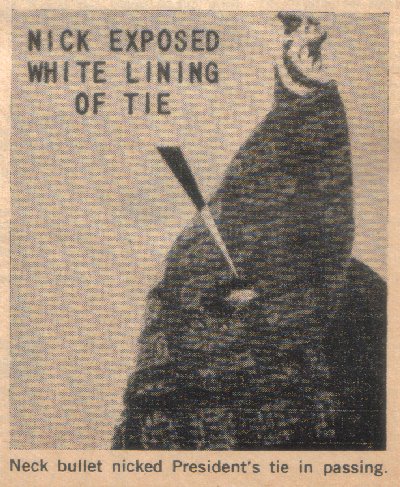
"On the other side of the coin, the
writers of the Warren Commission Report went to the opposite extreme
when they tried to force unanimity of opinion on all the doctors at
Parkland Hospital in support of the autopsy surgeons that the throat
wound had to be a wound of exit. When you put too much
tension on
the evidence, by pulling and tugging on it, in an effort to mold it to
the shape of a preconceived conclusion, you leave yourself pretty
vulnerable."
What about Commander Humes burning his original notes of
his draft of the autopsy protocol?
"It's
extremely unfortunate that he did; but I interpret this only as further
evidence of his lack of experience in medico-legal situations.
I
can't believe that there's anything sinister about it as some of the
critics would have you believe. Commander Humes simply did
not
appreciate that this was not just another hospital autopsy and that
every note or memorandum should be saved for later scrutiny."
Some
of the critics of the Warren Commission Report have attempted to
bolster their attacks by alleging that Commander Boswell's drawing (a
portion of Commission Exhibit 397) shows the bullet wound in the back
of the neck as being down about the level of the shoulder blades.
Is this significant?
"It's significant in that it
demonstrates the total ignorance of the critics in the matter of
autopsy procedures. We don't need to spend any time on trivia
like this; but for information, this is simply part of the work sheet.
It contains two purely schematic drawings of the human
figure,
one front and one rear, in what is known as the 'anatomic position.'
The doctor doing the autopsy uses them as a shorthand way of
making notes on what he observes during his external examination of the
body. Commander Boswell sketched in a number of observations,
including the surgical scars, the old scar from the President's back
operation and the bullet holes. No one ever pretends that
these
markings are drawn to scale. To take the time to do this
would
defeat the entire purpose of this shorthand way of making notes.
The written material in the autopsy protocol is what matters."
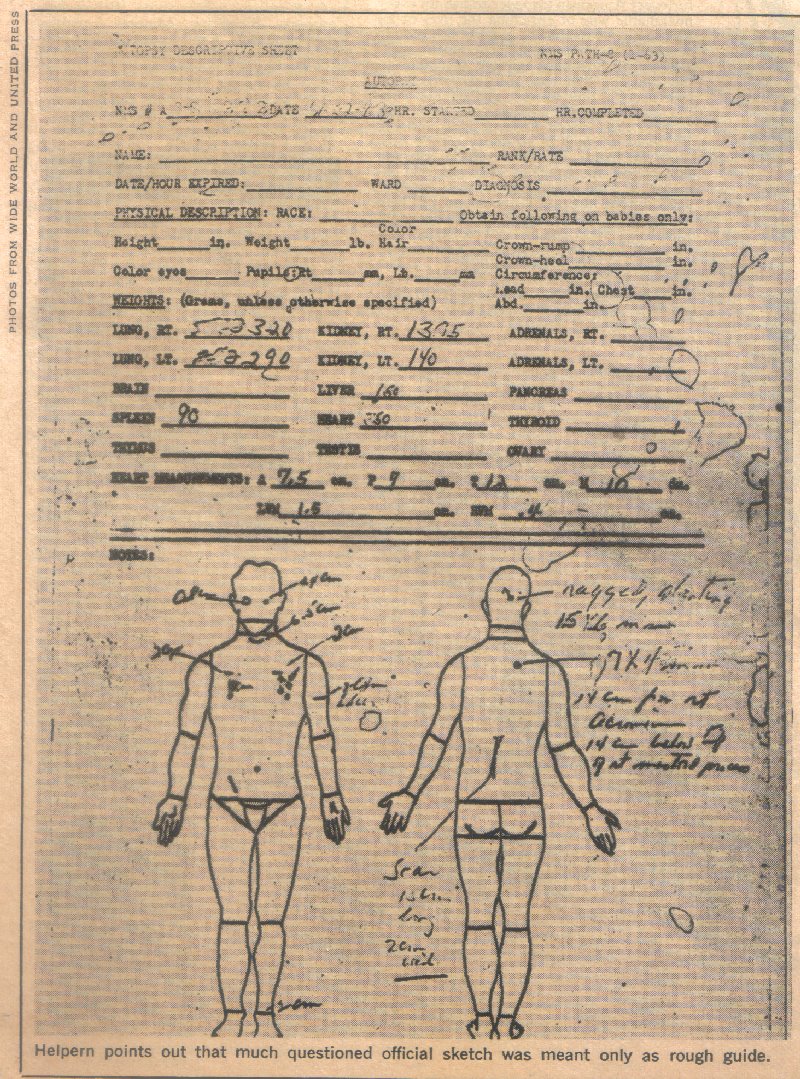
Some
critics have alleged some sort of duplicity because an FBI report dated
December 9, 1963, and another one dated January 13, 1964, apparently
contain information which is not consistent with the formal autopsy
protocol.
"This is more trivia and underbrush. What
difference does it make what these two FBI reports said? The
controlling factor insofar as the medico-legal phase of the
investigation is concerned is the autopsy protocol itself.
There
was undoubtedly conversation going on in the autopsy room.
The
FBI agent there probably heard the doctors agonizing over their
inability to find the bullet. He observed them trying to
probe
the neck wound. He heard their speculations that the hole in
the
back of the neck was both
a
wound of entrance and a wound of exit. To me, all that these
particular FBI reports show is exactly what we have mentioned before :
at the time the autopsy was finished, the doctors thought they were
dealing with only three bullet holes, two in the head and one in the
back of the neck."
Where
did the Warren Commission, as distinguished from the autopsy surgeons,
fail to clarify the medical issues of the President's death?
"It
failed tragically because it did not have sufficient knowledge in the
field of forensic medicine to even appreciate the need to call in an
expert with experience in bullet wounds in the body. This
lack of
knowledge is evident in the official report itself. For
example,
it contains thousands of exhibits in eleven volumes. They
include
all sorts of meaningless pictures of Marina Oswald. Oswald's
mother, Oswald as a young boy. Jack Ruby's employees or girl
friends in varying states of attire, and nine X-rays of Governor
Connally's body.
"The X-rays of President Kennedy's body,
however, were not considered significant enough to the entire
investigation to be filed as exhibits to the report. The same
holds true of the black and white and the color pictures of the bullet
wounds. These were never seen by the Commission members, its
staff, or even the autopsy surgeons before the report was finalized.
The Commission members, its staff, or even the autopsy
surgeons
before the report was finalized. The Commission said it would
not
'press' for the X-rays and photographs because these would merely
'corroborate' the findings of the doctors, and that considerations of
'good taste' precluded these from being included.
"Well, you see,
there was nothing that offended 'good taste' in the nine X-rays of
Governor Connally's body [Commission Exhibit 691]; so this great
curtain of secrecy that was pulled down on the X-rays and pictures of
the President's body added more explosive fuel to the fire of doubt.
There have been intimations that these X-rays and pictures
had
gone the way of Commander Humes' notes; and it was only after
considerable public pressure built up that the pictures and X-rays were
turned over to the National Archives by the Kennedy family in November
of 1966; but they are still shrouded by this great curtain of secrecy.
Secrecy is the natural culture medium for suspicion."
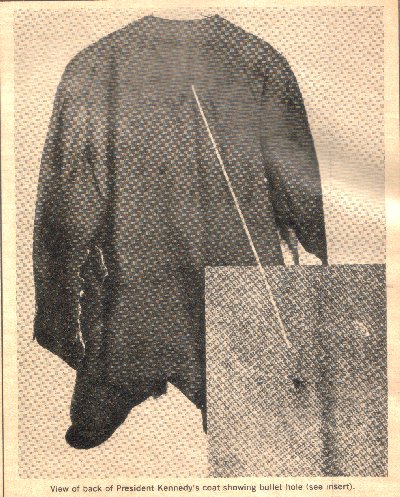
Why didn't the examination by the Navy doctors of the
X-rays and pictures in November of 1966, still the doubts of the
critics?
"Let's
come back to our analogy of the seven-year-old violin player.
We
sit him down in front of an electronic microscope and ask him what he
sees on a slide. He says: 'I don't see anything.'
We then
jump to the conclusion that there is nothing there because an
inexperienced eye can't see anything there."
What might these X-rays show to an experienced observer
that could have been completely overlooked by the nonexpert expert?
"Who
knows? Probably absolutely nothing. I don't like to engage in
rank, blind speculation; so I can only explain how I would approach
them. My first interest would be to see whether there could
be
another bullet or fragment of bullet in the body which has not been
accounted for.
"Remember that the Warren Commission
concluded that the preponderance of the evidence indicated that three
shots altogether were fired. Only one relatively intact
bullet
and the fragments of a second bullet were found. This leaves
a
missing third bullet. I definitely do not agree with the
Commission's conclusion that only two bullets cause all the wounds
suffered by President Kennedy and Governor Connally; but we'll pass
that for the moment.
"Since
the X-rays of the President's body were not filed as exhibits, we must
rely entirely upon the observations of the Navy doctors that they
skillfully eliminated the possibility that a third bullet, or a
fragment of some bullet, did not enter the body and somehow meander
down to come to rest in some illogical remote spot.
Apparently,
the doctors did not feel confident enough to rely on the X-rays during
the autopsy when they went probing, for the bullet that was found on
the stretcher in Parkland Hospital. They have now been quoted
publicly as saying that they did have the X-rays available to them that
night. Bullets do have a funny habit of showing up in the
most
astounding places in the body.
"I would also look for trace
flecks of metal that might indicate another head wound. This
possibility is extremely remote; but it still exists. Often,
quite often, wounds of entrance in the head are completely overlooked
because they are covered naturally by the hair. The wound may
barely bleed at all. If you don't take a comb and go over the
entire scalp, inch by inch, separating the hair carefully and
meticulously, it's easy to miss a head wound entirely. There
is
no evidence that this type of examination was made."
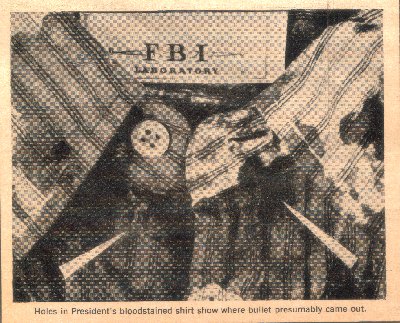
Would the X-rays help establish whether the two wounds
in the neck area were wounds of entrance or of exit?
"No, I would not expect them to be of help on this
question."
What about the black and white and the color photographs?
"These
could be of considerable interest and value. A lot would
depend
on their quality and how they were exposed. Hopefully, they
could
shed considerable light on the neck wounds. I would, of
course,
be interested in what the pictures of the rear neck wound would show;
but I would be particularly interested in seeing whether the pictures
of the throat wound are good enough to permit it to be evaluated and
possibly reconstructed."
Where else can the Warren Commission be faulted for what
it did or failed to do?
"Again,
it committed a grievous error of omission by failing to call in someone
who knew something about bullet wounds in the body. This led
them
into the final trap of buying Assistant Counsel Arlen Specter's theory
that the same bullet which passed through the President's neck was the
bullet that also wounded Governor Connally, shattering his fifth rib,
fracturing a bone in the wrist and finally coming to rest in his thigh.
Now, this bizarre path is perfectly possible. When you are
working with bullet wounds, you must begin with the premise that anything is
possible; but Mr. Specter and the Commission overlooked one important
ingredient.
"The
original, pristine weight of this bullet before it was fired was
approximately 160 to 161 grains. The weight of the bullet
recovered on the stretcher in Parkland Hospital (Commission Exhibit 399) was reported by the Commission as 158.6 grains. This
bullet
wasn't distorted in any way. I cannot accept the premise that
this bullet thrashed around in all that bony tissue and lost only 1.4
to 2.4 grains of its original weight. I cannot believe,
either,
that this bullet is going to emerge miraculously unscathed, without any
deformity, and with its lands and grooves intact."
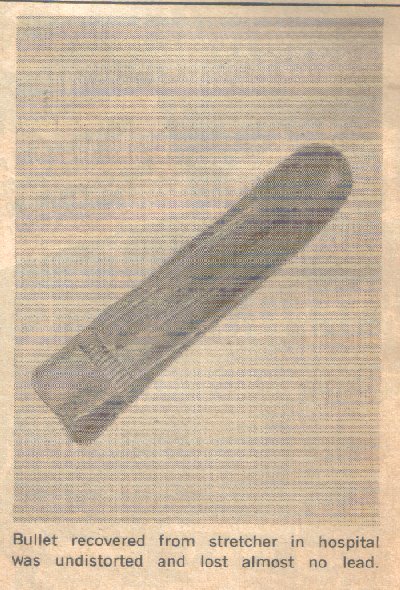
Does this shed any light on the other of the shots?
"In
my opinion, this was the first bullet that was fired. It
passed
through the President's neck, exited from the throat wound. and was
stopped by his clothing. I've seen this exact thing happen hundreds of
times. Remember that, next to bone, the skin offers greater
resistance to a bullet in its course through the body than any other
tissue. The energy of the bullet is sometimes spent so that
it
can't quite get out through the final layer of skin, and it comes to
rest just beneath the outside layer of skin. If it does get
through the skin, it may not have enough energy to penetrate even an
undershirt or a light cotton blouse. It has exhausted itself
and
more or less plops to a stop."
What about the Commission's conclusion that this bullet
was found on Governor Connally's stretcher in Parkland Hospital?
"It's
based on tortured evidence, or inconclusive evidence, to say the least.
No one will ever know for sure which stretcher this bullet
came
from. In my opinion, the probabilities are that it fell out
of
the President's clothing while the doctors were administering to him in
the hospital. For the sake of argument, however, let's
assume that
it was found on the Governor's stretcher. This still does not
rule out the premise that it was the first bullet that passed through
the President's neck. That spent bullet could just as easily
have
taken an erratic jump out of the President's clothing and lodged in
Governor Connally's clothing. These things happen with
bullets.
Sometimes they get through the final layer of skin and hop
limply
about at all arcs of the circle and at all angles to the wound of exit."
Do you agree with Governor Connally that he was struck
by the second
bullet?
"Yes,
I definitely do. His testimony is most persuasive.
I just
can't buy this theory that this beautifully preserved first bullet
which passed through the President's neck also got tangled up with the
Governor's rib and wrist bones. In my opinion, the second
bullet,
which wounded Governor Connally, is the one that is missing."
And the third?
"The
third one quite obviously is the one that caused the President's
massive head wound, and his death. Also, either a fragment
from
this bullet, or a piece of skull, caused the cracking of the windshield
and the dent in the windshield chrome on the interior of the limousine,
provided these marks on the car were not already present at the time
the shooting began."
Assistant Counsel Arlen Specter's creation
of the theory that a "single bullet" passed through the area of the
President's neck and went on to inflict all of Governor Connally's
wounds was necessitated, so he thought, by the Zapruder movie.
This "one-bullet" theory is perhaps the most amateurish
conclusion in the entire Warren Commission Report, and regrettably, it
permits the brand of "doubtful" to cloud the genuine, bona fide
Commission findings.
Abraham Zapruder is now undoubtedly the most
famous amateur movie photographer in all history. As he stood
in
Dealey Plaza aiming his home movie camera in an easterly direction, he
caught and recorded the Presidential motorcade as it proceeded north on
Houston Street, to make its turn west on Elm Street. This
innocent, famous home movie ended up by leading Mr. Specter and the
Warren Commission into an unfortunate trap.
Even those who have
purported to study the work of the Commission in considered hindsight
are still mesmerized by the beguiling and misleading power of the
Zapruder movie. For example, in its November 25, 1966 issue,
"Life" magazine innocently perpetuates the error. Its article
reads: "Of all the witnesses to the tragedy, the only unimpeachable one
is the 8-mm movie camera of Abraham Zapruder, which recorded the
assassination in sequence. Film passed through the camera at
18.3
frames a second, a little more than a twentieth of a second (.055
seconds) for each frame. By studying individual frames, one
can
see what happened at every instant and measure precisely the interval
between events."
The error that trapped the Warren Commission as well as
"Life" magazine is that there is nothing at all precisely measured
by the Zapruder film.
The nearest thing to a precise,
objective event which the film records is at Frame
313, which shows the
President's skull exploding as a result of the bullet that passed
through his head. Every other item purportedly measured by
the
Zapruder film is imprecise
because it must be evaluated and speculated upon through factors and
calculations which involve unknown quantities.
One
of the most common pitfalls in any investigation is the 'timetable
trap." The investigator becomes mesmerized by either a clock
or a
calendar and ends up with a conclusion that two and two are five, or
that some Florida oranges are red because Washington Delicious apples
are also red. This is exactly what happened to Mr. Specter
who,
unfortunately, was able to sell his erroneous theory to the Commission.
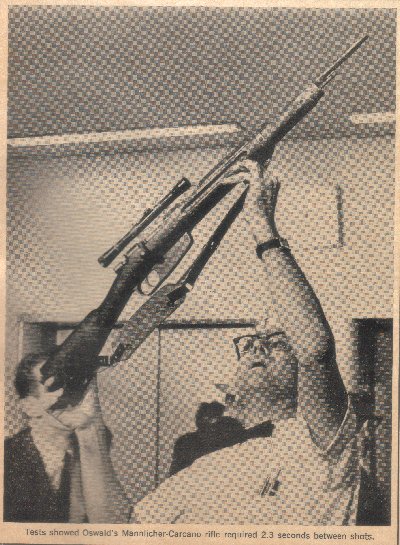
Some
time after the investigation into the President's death began, the FBI
staged a mock re-enactment of the assassination, which was geared to
and scripted by the Zapruder movie. An FBI agent was
stationed in
the sixth-floor window of the Texas School Book Depository Building
with a camera geared to the telescope lens of the Mannlicher-Carcano
rifle found at this same window minutes after the assassination.
An effort was made to synchronize
the Zapruder movie with what the assassin presumably saw from his point
of vantage at the sixth-floor window as the Presidential caravan moved
along its historic route.
It had previously been determined that
the Zapruder camera ran at the speed of 18.3 pictures or frames per
second. The timing of certain events, therefore, could be
calculated by allowing 1/18.3 seconds for the action depicted from one
frame to the next. Other tests had also determined that this
Mannlicher-Carcano rifle required a minimum of 2.3 seconds between each
shot fired.
Each frame of the Zapruder film was given a number,
Number 1 beginning where the motorcycles leading the motorcade came
into view on Houston Street, Combining the FBI re-enactment with the
Zapruder movie, it was concluded that the assassin had a clear view of
the President from his sixth-floor window as the limousine moved up
Houston Street, and for an additional one hundred feet as the
Presidential car proceeded west on Elm
Street. At a point
denoted
as Frame 166 on the Zapruder
film, the assassin's view of the President
became obstructed by the foliage of a large oak tree.*
*One of
the most incredible statements of the entire report appears on page 97:
"On May 24, 1964, agents of the FBI and Secret Service conducted a
series of tests to determine as precisely as possible what happened on
November 22, 1963.... The agents ascertained that the foliage of an oak
tree that came between the gunman and his target along the motorcade
route on Elm Street was approximately the same as on the day of the
assassination." The report does not say how this was
"ascertained."
The
President's back reappeared into view through the telescopic lens on
the rifle for a fleeting instant at Frame
186. This momentary
view was permitted by an opening in the leaves of the tree; but they
closed to again obscure the view of the President's back through the
telescopic sight until the car emerged from behind the tree at Frame 210.
The Commission implies that one of the difficulties in
interpreting the Zapruder film is that the President's car begins to
disappear behind a road sign reading "Stemmons Freeway Right Lane" at
approximately Frame 193.
At Frame 206, the
President's hand
is
still raised as he disappears behind the street sign. He
reappears in the film at Frame 225.
As a matter of fact, it
is
really not essential to the evidential value of the film whether the
President was or was not out of sight for some 30 to 32 frames.
There are those who viewed the Zapruder movie who thought that the
President looked as if
he was hit through the neck when he reappeared from behind the street
sign at Frame 234.
"Life" summarizes the subjective
factor
of interpretation by saying: "Specter sees Connally wincing in Frame 230. 'Life' photo
interpreters think he looks unharmed, as
does Connally himself."
Still, Mr. Specter labored under the illusion that the
Zapruder movie gave him a stop-watch precision measurement of events
that took place , not
in the Presidential limousine, but in the Texas School Book Depository
Building over one hundred feet back up Elm Street.
Mr. Specter did not
believe that he could solve of orienting the Zapruder movie to the
minimum time required to fire two shots from the Mannlicher-Carcano
rifle without adopting the "one-bullet" theory. The 2.3
seconds required to fire two shots from the rifle worked out to 42.09
frames of the Zapruder movie. Even assuming that the
President had been hit in the neck while he was behind the street sign
at, say, Frame 210, it would
not be possible for a second shot to be
fired until Frame 252.09.
This presented a difficult impasse, provided the
"timetable" supplied by the Zapruder movie was correct. Mr.
Specter assumed that this "timetable" was accurate and then adopted the
"one-bullet" theory to get around its limitations. Otherwise,
he was faced with the awkward admission that two guns were used
instead of one.
His better procedure would have been to carefully
analyze his "timetable" in an effort to understand exactly what he was
working with. By beginning with Frame
313 - the only
objective point of reference in the entire film where the picture of
the President's exploding skull was recorded - we can set up a reverse timetable by working
backward (See box below):

What does this reverse timetable
prove? It proves exactly the same thing as the forward timetable of
the Zapruder film - which is exactly nothing. Nothing is
proved because we do not know when the President and Governor Connally
were struck by the first and second bullets. There is
absolutely nothing in the frames of the movie to give us any precise
measurement. In the first place, we are in a quandary of
uncertainty as to when the President and the Governor
"reacted" to their respective wounds. It has already been
clearly established that different observers of the Zapruder film have
reached different opinions as to when these "reactions" took place.
We are dealing with subjective
evaluation, which completely kicks out the concept of any precise "timetable."
The next great error
that was committed in attempting to use the Zapruder film as a
"timetable" was the assumption that the President and the Governor
would have some visible reaction to their wounds at almost the exact instant that
the wounds were sustained. There is absolutely nothing in
medicine to indicate that this assumption is correct. As a
matter of fact, what is known about reaction time generally indicates
that the assumption may not
be correct at all.
It must readily be
admitted that the reaction time of any person to a bullet wound is a
purely speculative entity. No one has yet conducted a series
of experiments so that a set of rules governing reaction time to bullet
wounds can be formulated.
Studies have been made
of certain other types of reaction time in the field of
automobile-accident reconstruction where elaborate tests have been
given to drivers under controlled conditions. It has been
established that between the time the driver perceives a dangerous
event and the time that he applies his brakes or begins other evasive
action, an average reaction period of two-thirds to three-quarters of a
second elapses. In some individuals, this reaction time is
well over one full second. There is always some "drag" or
reaction time involved between the stimulus and the reaction to
stimulus. This is true, even though this type of stimulus is something
that the driver has been conditioned to expect and which he must
anticipate by the nature of the testing situation.
No one knows whether
there is an analogy between driver reaction time and bullet-wound
reaction time. It can be argued plausibly that driver
reaction time involves a conscious thinking process, whereas the
reaction of the body to a bullet is more nearly analogous to an
autonomic, reflex type of action. There are, however,
hundreds of reported cases in which the person shot apparently does not
realize that he has been shot for a period of several minutes.
He may continue to perform a number of complex, highly
co-ordinated functions for a substantial period of time before
collapsing to lose consciousness or to die.
Furthermore, Governor
Connally's reaction time to his wounds may have been hit at Frame 230
of the Zapruder film. He may have "reacted" immediately, so
that his "reaction" can still be observed by viewers of the movie.
this does not mean at all that the President could not have been shot
through the neck before Frame 166
when his back disappeared behind the
leaves of the oak tree, or at Frame 186
when his back reappeared
momentarily, and his observable reactions appear on the movie after
Frame 225 when the
President emerges from behind the road sign.
There is absolutely
nothing in the "open-end" Zapruder movie "timetable" to rule out the
possibility or even the probability that the President was shot through
the neck before Frame 166.
The error in using the Zapruder
film was in the assumption that the President would have to "react"
instantaneously to the neck wound in such a manner that his reaction
could be observed in the movie. The Zapruder film is not really a
"timetable" after all, because it can help establish the "location" of
only one "station" along the "railroad." It does not help us
pinpoint the other two important stations, nor does it tell us when the
train got there. We can use the Zapruder "timetable" to
conclude that the train got to one station probably no later
than Frame 225. It
reached the second station no later than
Frame 234. We
cannot tell from the Zapruder film what the
train was doing before these two locations, or even where our floating
stations one and two are located.
It was not necessary
for Mr. Specter to devise, nor for the Commission to buy, the
"one-bullet" theory to eliminate the necessity of adopting the
embarrassing premise that two
rifles were used to do the shooting instead of one.
Dr. Helpern's theory of
three separate bullets causing three separate wounds, two in the
President's body and one in Governor Connally, is not at all
inconsistent with the Zapruder movie when the movie is properly
interpreted as being nothing more than an open-end, one-station
timetable where the separate elements of time, distance and location
have been confused.
What about the "wound
ballistics experiments" conducted at the Edgewood Arsenal?
"Well," Dr. Helpern
responds, shaking his head in disbelief, "the mere fact that they felt
constrained to perform these tests in the first place shows a total
lack of knowledge on the subject of bullet wounds in the body.
They went down there and tried to rig up dummies that would
simulate the President's head and neck area. They took human
skulls, filled them with gelatin and covered them with goatskin and
hair. They rigged up a dummy with gelatin and animal meat to
simulate the neck area of his body. Then they got a goat to
simulate Governor Connally's body. They took the rifle found
in the Texas School Book Depository Building and began firing into
these dummies. All they proved was that they proved
absolutely nothing. One of the experts was utterly surprised
that a bullet could cause the massive wound in the President's head.
His surprise alone indicates his limited experience.
"We have all kinds of
cases in our files that show what bullets can and have done in the
human body. So does everyone else who is active in the field
of forensic medicine. For example, Dr. LeMoyne Snyder has a
case that almost duplicates the President's head wounds in every
respect. It arose out of a bank holdup in Michigan.
A dentist who had his office on the second floor of a
building directly across the street from the bank went to the window to
see what the trouble was. He saw one of the bandits running
down the street, with people yelling after him. The dentist
was quite a deer hunter and kept a rifle in his office. He
reached for his rifle, raised the window and hit the bandit in the back
of the head with a single shot. By that time, the bandit was
just about the same distance away as the Presidential limousine was
from the sixth-floor window of the Texas School Book Depository
Building when the first shot struck. The head wounds this
bank bandit sustained were almost identical in every respect to those
of President Kennedy.
"Nevertheless, the
Commission chose to rely on the synthetic tests at the Edgewood Arsenal
to support its conclusion that a single bullet probably caused the
wound through the President's neck and all of Governor Connally's
wounds. This was done even though one of the three experts,
Dr. Light, testified that the anatomical findings alone were
insufficient for him to formulate a firm opinion on whether the same
bullet did or did not pass through the President's neck wound first
before inflicting all the wounds on Governor Connally."
Is there anything in
the overall picture to cast serious doubt on the principal conclusions
by the Commission?
"Of course, I haven't
seen the pictures and the X-rays of the President, but on the basis of
the evidence that has been made public, the Commission reached the
correct opinion that all three bullets were fired by one rifleman from
the sixth-floor window of the Texas School Book Depository Building.
The unfortunate autopsy and other procedures have merely
opened the door and invited the critics to enjoy a Roman holiday at the
expense of the dignity and prestige of the country as a whole."
"The fact that a
rigorous cross-examination of the three autopsy surgeons would have
ripped their testimony to shreds does not necessary mean that their
conclusions were totally
wrong in its opinion that all the shots came from the Depository
building. What it means is that the Commission members
themselves set the stage for the aura of doubt and suspicion that has
enveloped their work.
"The Commission of
course, was an unusual creature. It was itself a synthetic
entity. It was extra-judicial, extra-executive and
extra-legislative. It was supposed to be a public forum of
the courtroom because the normal forum of the courtroom was wiped out
when Jack Ruby killed Oswald. If Oswald had lived, all the
evidence about the President's death could have been aired in the
courtroom and all the witnesses would have been open to
cross-examination. In its procedures, the Commission failed
to supply anything that would fill the disastrous void left when the
right or motive to cross-examine the witnesses was wiped out.
They did not provide for the essential Devil's
Advocate."
"The biblical saying
that 'a man is judged by his work' may be appropriate. The
Commission's work opened the door and invited the critics to flood in."
Is there anything
specifically Dr. Helpern would like to see done at this point?
"It may well be too
late to do anything, since the primary evidence is gone.
There is a possibility, however, that the X-rays and
photographs of the President's wounds might contain some clarifying
information. I would certainly feel more comfortable about
the Warren Commission's findings if a group of experienced men, who
have had a great deal of practical work in bullet-wound cases, could
take a look at these X-rays and pictures. I have in mind men
like Dr. LeMoyne Snyder, author of 'Homicide Investigation,'
Dr. Russell Fisher, the medical examiner for the State of
Maryland, Dr. Frank Cleveland in Cincinnati, and Dr. Richard Myers in Los
Angeles. These men are all members of the American Academy of
Forensic Sciences. These pictures and X-rays might, and I
emphasize might,
settle the questions raised by the critics once and for all.
"The tragic thing is
that a greatly loved President was not given the same type of expert
medical attention and medical respect in death that he received in
life. When he was having back problems, he properly consulted
the leading experts in the field of orthopedic surgery; but, you see,
in death, the task of evaluating his bullet wounds was not given to
experienced experts in this field. It was still the old saw
that an autopsy is an autopsy is an autopsy, and anyone can do it,
particularly as long as he is a pathologist."
What about the portions
of the autopsy protocol that have not been released to the public?
"There, I think." Dr.
Helpern answers, "are personal matters that should be left entirely to
the family, although I do think that the public is entitled to the most
expert and definitive determination possible on the bullet wounds that
caused death.
"I know it has been
argued that, since the question of whether the President did or did not
have Addison's disease was injected as an issue into the 1960
Presidential campaign, the public is entitled to know if any findings
at the autopsy tended to substantiate this allegation.
"Some of my collegues
also argue that if the autopsy findings did show a deterioration of the
adrenal glands, which would be evidence of Addison's disease, it is a
missed opportunity for showing the progress of medicine in general to
fail to disclose it. A person suffering from Addison's
disease can now be placed on medication so that the disease can be
controlled in much the same manner that diabetes is
controlled by insulin. This, of course, was not true a
generation ago. These fellows continue that it would
dramatically show medicine's progress if a man with Addison's disease
could be treated so successfully that he could function well enough to
perform the duties demanded by the office of President of the United
States.
"I still go along with
the feeling that any disclosure in the autopsy findings over and above
the bullet wounds which produced the President's death must be
considered a private matter for the family to do with as they
personally desire."
Costella Combined
Edit Frames
Zapruder film
frames referenced located here
JFK Doctors Are Dying
Read story here
Lies
about the Kennedy and Forrestal Deaths
Read story here
This one's for John
Barbour, with love.
Lorie Kramer
seektress@seektress.info |
